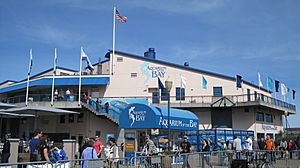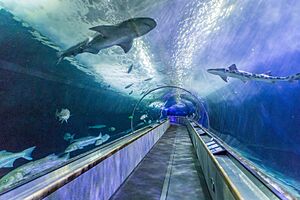Aquarium of the Bay facts for kids
 |
|
| Date opened | 19 April 1996 (29 years ago) |
|---|---|
| Location | San Francisco, California, United States |
| Land area | 65,000 sq ft (6,000 m2) |
| Coordinates | 37°48′32″N 122°24′33″W / 37.8087548°N 122.4092956°W |
| Total volume of tanks | 770,000 US gal (2,900,000 L) |
| Annual visitors | 600,000 |
| Memberships | AZA |
The Aquarium of the Bay is a cool public aquarium located right on The Embarcadero at Pier 39 in San Francisco, California. This aquarium is special because it focuses on animals that live in the San Francisco Bay and the rivers and streams nearby. It even includes animals from as far away as the Sierra Nevada mountains!
It's a Smithsonian Affiliate, which means it's connected to the famous Smithsonian museums. It's also approved by the Association of Zoos and Aquariums (AZA), showing it takes great care of its animals. Plus, it's certified as a Green Business by San Francisco, meaning it's good for the environment.
Contents
History of the Aquarium
How the Aquarium Started
The idea for the aquarium began a long time ago. It was first planned to open in 1988. However, there were some delays. People living near Fisherman's Wharf and environmental groups had concerns.
They worried about how much land would need to be added to the Bay. They also wanted to make sure the aquarium followed city rules about waterfront property. Construction finally started in July 1995.
The city set some rules for the aquarium to get approval. It had to only show animals found in the San Francisco Bay. It also had to offer educational programs for visitors.
Opening as UnderWater World
The aquarium first opened on April 19, 1996. It was called UnderWater World back then. Building it cost about $38 million. It started with around 4,000 fish from 100 different species that live in the San Francisco Bay.
One of the main attractions is two long tunnels made of clear material. These tunnels are about 360 feet long! They go through two huge tanks filled with 707,000 gallons of filtered Bay water.
When it first opened, the aquarium hoped to have many visitors. However, not as many people came as expected. Some visitors even joked that it should be called "Underwhelming World." The aquarium faced financial trouble in 1999.
Becoming Aquarium of the Bay
In 2000, a new group bought UnderWater World. They decided to rename it Aquarium of the Bay in 2001. They also planned to add more sea animals.
The aquarium was updated with new exhibits. It reopened with its new name on July 12, 2001. It now had 273 species and over 60,000 fish!
A Nonprofit for Education
In 2009, a group called The Bay Institute bought the aquarium. This was a big change! The aquarium's main goal became education and research. It is now a nonprofit center.
This means the aquarium focuses on teaching people about the San Francisco Bay. It also does important research to protect the Bay's animals.
Animals You Can See
The Aquarium of the Bay is home to many amazing creatures. You can see over 50 different sharks! Some of the sharks include:
- Broadnose sevengill shark (Notorynchus cepedianus)
- Leopard shark (Triakis semifasciata)
- Soupfin shark (Galeorhinus galeus)
- Swell shark (Cephaloscyllium ventriosum)
You'll also find other cool animals like skates and bat rays. There are thousands of other fish too. These include eels, flatfish, rockfish, and sturgeons.
A special exhibit opened in 2013 for North American river otters. These otters are very playful! Sometimes, during winter, the aquarium even brings in snow for them to play in. These are called "Otter Snow Days."
Studying Bay Animals
The aquarium staff helps study animals in the Bay. They tag sevengill sharks to learn about their lives. This helps them understand where these sharks raise their young in the Bay.
They also work with scientists to study how anchovies smell and how plastic affects them. The aquarium helps with many research projects. They especially focus on sharks and rays.
Explore the Exhibits
The aquarium has four main areas for you to explore. Each one offers a unique look at Bay animals.
Discover the Bay
This area has many smaller tanks. You can see all sorts of animals here. Look for moray eels, anchovies, and rockfish. You might also spot decorator crabs and colorful garibaldi. The garibaldi is California's state marine fish!
Under the Bay
This is the biggest exhibit at the aquarium. It has 300 feet of tunnels that you can walk through! You'll see thousands of aquatic animals and other sea creatures. This exhibit is designed to look just like the San Francisco Bay underwater. You can even see beautiful jellies floating by.
Touch the Bay
This exhibit lets you get hands-on! You can gently touch several types of animals. These include bat rays, skates, and leopard sharks. You can also feel sea stars, anemones, and sea cucumbers. This area also has land animals like frogs, toads, newts, and snakes.
North American River Otters
Come watch the North American river otters! They are some of the most playful animals at the aquarium. You can see them swim, play, and wrestle. You might even catch an otter feeding time and learn how the staff trains them.
Images for kids
-
Dungeness crab on exhibit
-
A bat ray at Aquarium of the Bay























